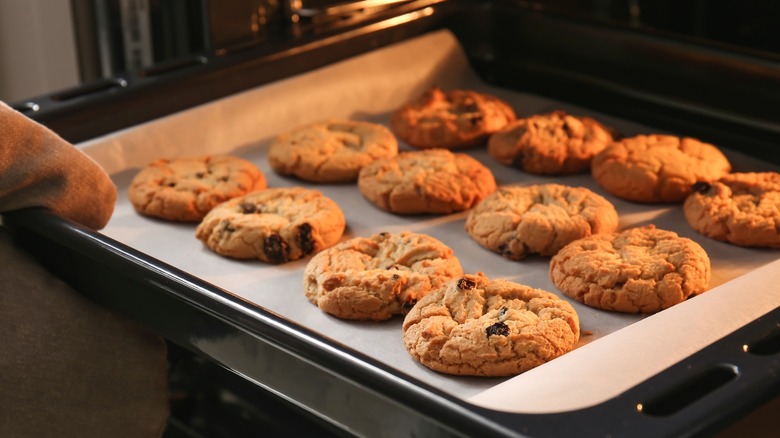The Overlooked Step That Ruins Your Bakes While In The Oven
It's alarming how tasty oven bakes can go from gastronomic gems to complete disasters in what feels like the blink of an eye. Sometimes, for seemingly no reason whatsoever, pastries and cakes can take a turn for the worse; ruining all the hard work you put into measuring out ingredients like a chemistry student. Still, culinary catastrophes typically occur through human error. According to Vivian Villa, chef and founder of Villa's Authentic Sauces as well as UnButter, one of the primary reasons food gets ruined in the oven is assuming that once it goes in, it doesn't need any attention until your timer dings.
"Ovens have hot and cold spots," Villa told The Takeout "The rotating of pans exposes baked goods to all spots, which results in evenly baked product." If you have newer oven, you may think this is advice reserved for older, more budget kitchens. Well, congrats on having a stellar kitchen appliance, but unfortunately, you are sadly mistaken. "All ovens have hot spots depending on where the heating elements are located and the structure of the oven," she said. "Rotating of pans is recommended in all ovens, including convection."
You can test the accuracy of your oven's temperature with sugar, but how does one determine where hot spots are and how should bakes be rotated to avoid overexposing them to too much heat? "Hot spots are where the heating element is located in the oven," Villa said. "Pans should be rotated to opposite locations (top to bottom, back to front) so that the item is not spending too much time in either a cooler or hotter spot."
Make it easy to rotate your bakes in the oven
You should always preheat your oven, whether you're baking sugary treats or a savory chicken dish. Once preheated, preventing hot air from escaping is essential for accurately cooking any food that goes inside. With that in mind, Villa recommended folks minimize their time rotating the bakes by planning ahead and making it easier on themselves. "Not overcrowding the oven with multiple pans facilitates quicker rotations," she said. "The racks should be in place prior to heating the oven — adjusting them during the baking process allows too much heat to escape."
While the previously mentioned chicken fare might be robust enough to come out of the oven looking just fine without much rotating, all those sweet after-dinner goodies are a bit more dainty and need to be treated as such. "Delicate cakes and pastries demand ... rotation during the baking process to ensure even rise and color across the surface of the product." A piece of chicken with a little extra char could add a welcome characteristic to the flavor profile, but a scorched pastry is a ruined pastry.
It's worth considering the size of the pan as well to ensure they receive even heat throughout the cooking process. "A larger-sized pan should be quarter turned in addition to rotation to ensure even baking." The larger the pan, the more exposure the food on it has to various spots in the oven, which increases the likelihood that one side is cooking at higher heat than the other.

